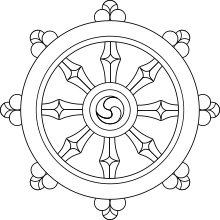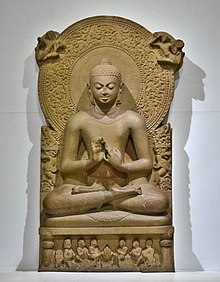Dharmachakra
Dharmachakra ( Sanskrit , m., धर्मचक्र, dharmacakra , the "wheel of law", from Chakra = wheel and Dharma = law) is the symbol of the teachings proclaimed by Buddha in Buddhism .
Representations
The Dharma wheel is usually represented with eight spokes, which symbolize the " Noble Eightfold Path " to liberation.
After India's independence (1947), Bhimrao Ramji Ambedkar insisted on adding a wheel with 24 spokes as an emblem in the flag of India based on the dharmachakra . This symbolism goes back to the rule of the Maurya Emperor Ashoka in the 3rd century BC. BC, who had the dharmachakra represented on pillars as a sign of the rule of the (Buddhist) law throughout his empire.
After Sri Lanka's conversion into a republic on May 22, 1972, the Dharmachakra was also included in the official Sri Lankan coat of arms . There is also a Dharmachakra in the seal of the Tibetan government in exile .
Jokhang Temple in Lhasa
Dharmachakramudra
Buddha images show different hand positions ( mudras ); One of them is the gesture of 'setting the wheel of teaching' ( dharmachakramudra ) in motion , which is closely connected to Sarnath (near Varanasi ) , in which the index or middle finger of the left touch the index finger and thumb of the right hand that are brought together in a kind of explanatory gesture. Only the back of the left hand and the surface of the right hand can always be seen.
Character encoding
The character can also be found in the Unicode block Various symbols :
| Unicode number | Characters (400%) |
category | Bidirectional class | Official name | description |
|---|---|---|---|---|---|
| U + 2638 (9784) | ☸ | WHEEL OF DHARMA |
Web links
Single receipts
- ↑ cf. “Sutta on putting the wheel of teaching in motion ” Dhammacakkappavattana Sutta ( Samyutta-Nikaya SN 56.11) on palikanon.de and in the English translations by Peter Harvey et al. a.
- ↑ Klaus-Josef Notz: Herders Lexikon des Buddhismus , S. 133, 2007, Erftstadt: Hohe







